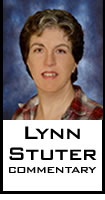Related
Article:
Who
Are The Bad
Guys - Democrats
Or Republicans?
Other
Stuter
Articles:
Justice For All
Or Justice Fon
None
System
Governance Bankrupting
States
Are Public
Schools
Constitutional
Homeschools, Private Schools,
and Systems Education
By Lynn Stuter
November 28, 2003
NewsWithViews.com
On October 3, 2003, Secretary of Education Rod Paige and First Lady Laura Bush were in Paris to mark the return of the United States to the United Nations Education, Scientific and Cultural Organization (UNESCO).
In his comments, made before the Round Table of Ministers on Quality Education, Secretary Paige referenced the UNESCO program, Education For All. He then went on to say,
"Education for All is consistent with our recent education legislation, the No Child Left Behind Act. Congress passed President Bush's reform proposal with support from both our political parties. Now I spend my days, along with thousands of educators throughout the United States, implementing these historic reforms."
Education for All consistent with No Child Left Behind? Being as how education reform is bottom-up, grassroots, and local in flavor, how is it possible that it could be consistent with Education for All or vice-versa? Just coincidence?
A lesson in history is called for.
In March 1990, the very first meeting of the World Conference on Education for All (WCEFA) was held in Jomtien, Thailand. The goal of the meeting was to "launch a renewed worldwide initiative to meet the basic learning needs of all children, youth and adults."
From this conference came "world education goals". Reverend James Patrick (1994) has compared the world education goals of the WCEFA and those of America 2000. It is obvious that, although the words are not exactly the same, the two sets of goals are the same.
In October/November 1991, the First Annual Conference of the United States Coalition for Education for All (USCEFA) was held in Alexandria, Virginia. The Honorary Chair of that conference was none other that First Lady Barbara Bush, mother of now president George Bush Jr.
In documents put out by USCEFA on the conference, it is stated that "USCEFA was created as an outgrowth of the World Conference on Education for All."
Those same documents state that:
"Participants will help create and shape future education agendas through USCEFA's action-oriented conference format ... The product of the conference will be an action document for shaping education reform initiatives in the United States and other countries. This action agenda will reflect domestic and international research and practice."
Following are the plenary sessions offered to participants:
� Access, Quality and Gender
� Assessing the Readiness of Children for School and Life
� Beyond Chalk and Talk: Creative Methods for Instruction and Assessment
� Building Coalitions for Children: Empowering Parents and Communities
� Child Care, Women's Work and Child Development
� Childrearing Practices in a Changing World
� Computers as Educational Tools: Do They Really Make a Difference
� Designing Education for the 21st Century
� Early Childhood Programming and Implementation Issues
� Education for a New World Order
� Education Leadership for the Future: How to Build Coalitions and Budgets
in Unconventional Times
� Expanding Literacy: Preparing for Participation in an Information Society
� Getting Started: Initiating and Maintaining Sustainable Education Reform
� Improving Education Quality through Distance Learning
� International Cooperation for Education for All
� Lessons from School Restructuring in the US
� The Missing Link: Integrating Health, Nutrition and Education
� Media and Early Childhood Education
� Mobilizing Media in Support of Education
� Mobilizing Public Support for Quality Education
� Multicultural Education: Valuing Diversity in Today's Multi-Ethnic/Multi-National
Classroom
� New Technologies for Teacher Training
� New Visions for Education
� Programming for Early Childhood Development
� Training Educators for Schooling in the 21st Century
� Using Media for Basic Education Outside the Schools
Reading through this list of session titles, buzz words heard repeatedly in meetings on education held in communities across the United States since 1993 abound.
The list of participants at this conference covers
seven pages, two columns to a page. Of particular note are representatives
from:
� Academy for Educational Development
� American Federation of Teachers
� Apple Computer
� Association for the Supervision of Curriculum Development (ASCD)
� Business Roundtable
� Council of Chief State School Officers
� Education Development Center
� Far West Regional Lab for Educational Research and Development
� Federal Office of Maternal and Child Health
� Houghton and Mifflin Company
� International Business Machines (IBM)
� MacMillan/McGraw Hill International
� National Center for Education Statistics
� National Middle School Association
� National Occupational Informational Coordinating Committee (NOICC)
� National School Boards Association
� Public Broadcasting System (PBS)
� U.S. Department of Education
� U.S. Department of Labor
� White House, Office of Policy Development
Names many will recognize as also being involved in education reform in the United States.
Several universities also participated:
� Arizona State University
� California State University (San Bernadino, California)
� Clark University (Amherst, Massachusetts)
� Florida State University
� George Washington University
� Harvard University
� Kent State University
� Michigan State University
� Ohio State University
� Old Dominion University (Norfolk, Virginia)
� Stanford University
� University of Massachusetts
� University of North Florida
� University of Oregon
� University of Pennsylvania
With few exceptions, these are all well-known and easily recognized universities turning out a large number of teachers trained to teach in the classroom, both at the elementary and secondary level and in higher education in schools, colleges, and universities nationwide.
The organizations supporting the 1991 USCEFA conference
is also a list of who's who, including:
� Academy of Educational Development
� American Association of School Administrators
� American Federation of Teachers
� Apple Computer
� Copen Family Foundation
� Education Development Center, Inc
� International Business Machines (IBM)
� National Center for Education Statistics
� National Education Association
� National School Board Association
One name here stands out, in particular � Education Development Center, Inc or EDC. The president of EDC, at that time, was Janet Whitla. Interesting, Ms Whitla was also the president, at the same time, of the United States Coalition for Education for All � the United States' response to the World Conference on Education for All.
What is the significance of Ms Whitla being the president of both USCEFA and EDC? The answer lies in what the Education Development Corporation is and what it does:
"Education Development Center, Inc, (EDC), is an international nonprofit research and development organization committed to human development through education and training ... With 37 years of experience in curriculum development, EDC works with employers and educational institutions to translate skill standards into curriculum and training programs and to integrate STW into school reform."
In response to the passing of the School-to-Work Opportunities Act in 1994, the National School-to-Career Consortium was established:
"The National School-to-Career Consortium is a collaborative of 21 organizations under the leadership of Education Development Center, Inc. (EDC) availing their knowledge, experiences, and resources for technical assistance to states with School-to-Work Opportunities Act (STWOA) Implementation grants."
In short, EDC became a technical assistance provider to states seeking federal grants under STWOA. Washington state, for example, paid EDC $31,000 to:
"Provide continued technical assistance on a federal grant application for development of a statewide School-to-Work system."
In all, Washington state would pay over $340,000 to EDC for their assistance.
It is imperative to remember that the only way a state can obtain a federal grant is by agreeing to abide by the terms and conditions set forth in the request for proposals (RFP) governing the grant. EDC's job was to insure Washington's grant proposals would meet the terms and conditions set forth in the federal request for proposals.
Present at the USCEFA was both the United States Department of Labor and Department of Education, overseeing federal grants to states for education reform and school-to-work, in which schools would become the avenue for human resource development: the training of young people to be workers; what is commonly called "polytechnical education" in eastern bloc nations.
Instrumental in the transformation of schools to human resource development is EDC, both as the head of the consortium providing technical assistance to states on school-to-work and as a technical assistance provider themselves. At the same time, the president of EDC was Janet Whitla, first president of USCEFA.
And lest we forget, former First Lady Barbara Bush, mother of President George Bush, Jr, was the first honorary chair of USCEFA.
Is it any coincidence that Education for All is consistent with No Child Left Behind (NCLB)? Connecting the dots makes how this came about more understandable.
Of Note:
Some may find it of interest, in further connecting the dots, that in documents put out by the Superintendent of Public Instruction in Washington state, following the passing of NCLB, it is stated that NCLB is:
"... a national extension of the standards-based education reform efforts we have undertaken in our state since 1993."
NCLB is, in essence, a new strategic plan, replacing the old strategic plan of the Clinton Administration � The Improving America's Schools Act or IASA. The IASA was, and NCLB is, the re-authorization of the Elementary and Secondary Education Act of 1965 or ESEA.
Special thanks to Peggy Cuddy, mother of Dr Dennis Cuddy, for bringing the words of Dr Paige, printed in the November 1, 2003, edition of The Achiever to my attention. Thank you, Peggy, for your long and outstanding service to our country.
Resources:
EDC National School-to-Work Technical Assistance Provider RFI; 1997.
EDC National STW TA Provider RFI; 1997.
Patrick, James R.; America 2000 / Goals 2000 � Moving the Nation Educationally to a "New World Order"; Moline, IL: Citizens for Academic Excellence; 1994.
United States Coalition for Education for All; conference documents and Conference Report; 1991.
U S Department of Education; The Achiever; Washington DC: USDOE; November 1, 2003.
Washington State; Office of Financial Management; contracts with EDC.
Washington State; Office of the Superintendent of Public Instruction; Memorandum No. 20-02M; April 15, 2002.
� 2003 Lynn M. Stuter - All Rights Reserved
Sign
Up For Free E-Mail Alerts
Mother and wife, Stuter has spent the past ten years researching systems theory with a particular emphasis on education. She home schooled two daughters, now grown and on their own. She has worked with legislators, both state and federal, on issues pertaining to systems governance and education reform. She networks nationwide with other researchers and citizens concerned with the transformation of our nation. She has traveled the United States and lived overseas. Web site: www.learn-usa.com E-Mail: lmstuter@learn-usa.com�
"From this conference came "world education goals". Reverend James Patrick (1994) has compared the world education goals of the WCEFA and those of America 2000. It is obvious that, although the words are not exactly the same, the two sets of goals are the same."





